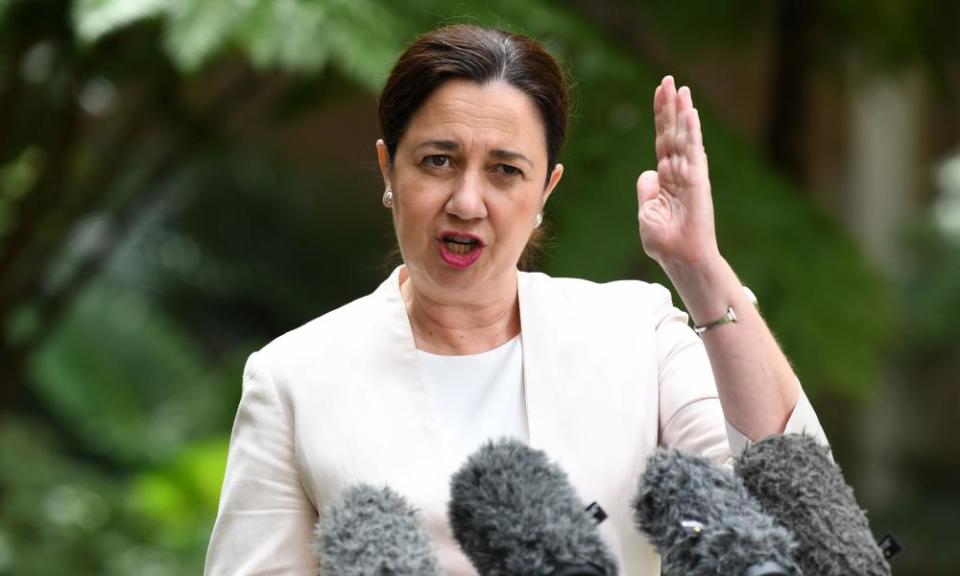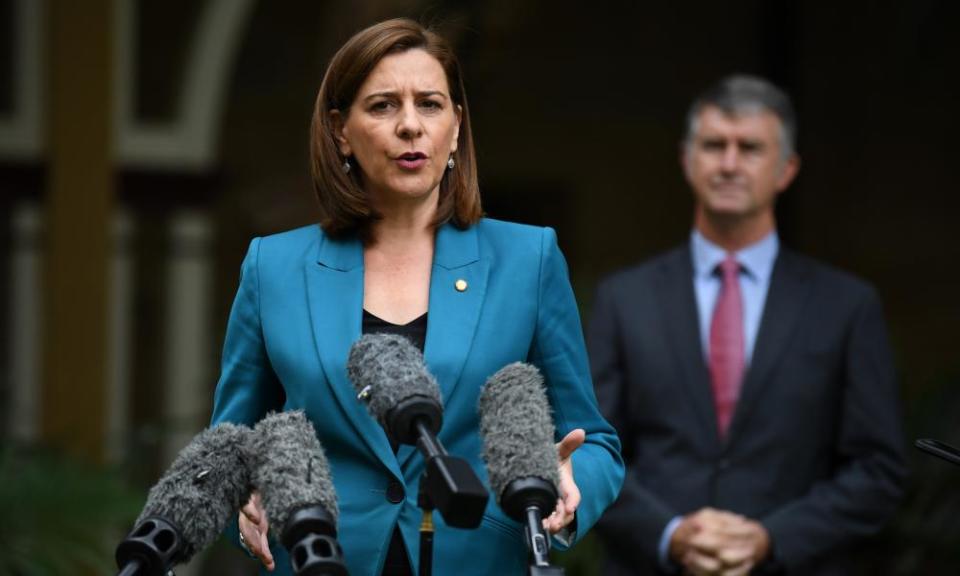Crime and embellishment in Townsville: how a local 'myth' could swing the Queensland election
On the eve of the Queensland election campaign, a “flying squad” of specialist police officers from Brisbane has been sent to round up known repeat offenders in the northern city of Townsville, where the government holds three marginal seats.
The local newspaper, the Townsville Bulletin, has dubbed its own city “Crimsville”, saying it is the state’s “undisputed crime capital”.
The local narrative that irredeemable (mainly Indigenous) offenders are terrorising law-abiding (mainly white) citizens in Townsville has been amplified by some politicians, police, residents and media outlets for the past decade.
Related: Can Annastacia Palaszczuk hold on to 'fortress Queensland' in the Covid election?
Criminologists say Townsville has become a “crucible” for statewide criminal justice policy – the result of perceptions about a crime crisis in the city combined with the relative political importance of its electorates.
Ahead of the state election on 31 October, Labor, the Liberal National party, One Nation and Katter’s Australia party have each announced populist “tough on crime” policies to more severely punish young offenders. They are pitched at voters in Townsville.
But academics, justice activists and local Indigenous community leaders have questioned the crime hysteria that has underpinned the political debate.
No expert disputes that crime is a problem in Townsville, where the rate of offending is marginally higher than other regional areas in Queensland. But evidence suggests the notion of an unending crimewave or “exploding” problem has been greatly overblown. And the result is recycled punitive policy ideas that experts say are proven failures.
‘Townsville is a real redneck place’
“I am so furious about the exaggeration, because there’s crime everywhere,” says the academic and Townsville-based Indigenous activist Gracelyn Smallwood.
“There’s just as much crime in Brisbane. But Townsville is a real redneck place, named after [the slave trader] Robert Towns. There’s vigilantes trying to run over our little innocent black children in the street. There’s only a small percentage that are mucking up in the streets.”
Crime statistics show a large contributor to high crime rates in Townsville are drug offences, which have increased 162% in the 15 years to 2019. The Griffith University criminologist Tarah Hodgkinson says this probably reflects a change to policing strategy, rather than a raw increase in drug crime.
Smallwood says the police have been “ramping up”.
“They’re doing more now because of the Black Lives Matter campaign. They’re charging kids stealing a boiled lolly and a can of Coke.
“They’re always stereotyping black children. Our kids had calmed down with intervention by respected elders, grassroots elders, and they’ve turned their lives around. I’m over these conservative people who don’t know our people, who don’t know unresolved grief, loss and trauma.”
Debbie Kilroy, the chief executive of the prisoner advocacy service Sisters Inside, says local concern about crime is “amped up rubbish”.
“We know [problems are caused by] a small group of families, the government has known that for decades, but instead of working with communities in a way that supports them, it’s always been an incarceration position ... when you do that they’re going to hate authority more and more.
“It’s all about the law and order option, who is going to get in power, instead of really showing some courage and leadership.
“The vigilantism is out of control and the media lays right over the top of that and drives a fundamentally racist agenda.”
Fuelling a moral panic
Police have raised alarm about escalating vigilante behaviour in Townsville and the prevalence of semi-organised street patrols, including mostly young white men who drive around looking for stolen cars. Video has shown them involved in dangerous high-speed pursuits.
Concerns have also been raised about the role of Townsville’s remarkably large social media anti-crime communities, which have evolved into some of the state’s most influential lobby groups.
When the LNP government under Campbell Newman passed stricter youth justice laws in 2014, the largest of these groups – Townsville Crime, Alerts & Discussions – was cited in parliament as representative of the community.
Every time a car is stolen, the incident is amplified on the crime alerts Facebook group with 48,000 members – more than a quarter of the Townsville population.
The page is moderated by a large group of community members, who have said previously they intend to function like a neighbourhood watch and do not tolerate vigilante behaviour or racist comments.
Related: Piling into Palaszczuk: LNP gambles by targeting premier in Queensland election
One member recently posted in the group about four Indigenous people who “appear to be casing houses and cars”.
Prof Chris Cunneen, a criminologist at James Cook University in nearby Cairns, co-authored a 2018 study on social media, vigilantism and Indigenous people, which concluded that community anti-crime pages fuelled moral panic and contained “overtly racialised content”.
The study – which looked at the Townsville Crime, Alerts and Discussions page and three others – suggested these social media groups furthered populist “tropes” that crime rates are soaring, the criminal justice system is weak or loaded in favour of criminals, that courts should impose tougher penalties, and that victims want retribution.
“It amplifies [crime] in the sense of people see it as a problem that’s greater than what the data would necessarily indicate,” Cunneen told Guardian Australia.
“[Social media posts] often identify a problem with a particular group of people – Aboriginal kids. It’s really dangerous … there’s been plenty of examples of children being identified through photos or locations.
“The other problem in Townsville is that it’s a racially polarised community and this crime stuff ties into that.”
‘Everyone knows someone who has been a victim’
Jenny*, a Townsville resident, says her home in the suburb of Gulliver has been broken into three separate times in the past year. She did not want to be named.
“You can throw whatever statistics you want out there, but when you are a victim and someone kicks down your door, what difference does the crime rate make?” she says.
“What does a number mean to me when I’m having to buy new locks again? Everyone knows someone who has been a victim. No one I know will support that [the idea that the crime crisis is exaggerated].
“But I guess where I differ from some of them is that I don’t want the kids who broke in here to suffer as payback or whatever. I’d just like it not to happen again.”
Overall crime rates have increased marginally in Townsville over about 20 years; the total rate is 14 offences each year for every 100 people. In Cairns the rate is 13 per 100. In Toowoomba, 12 per 100.
Related: Queensland LNP frontbencher tells new citizens not to bring problems to Australia
Property crime – the sort most complained about on Facebook pages and in local media articles – has declined consistently since 2001. The rate of break-ins has halved since 2001.
Mark David Chong, a Townsville-based criminologist at James Cook University, says that in the longer term, increases to total crime have been relatively insignificant. But over the same period, certain “signal crimes” – a term to describe offences that create a disproportionate amount of public fear such as sexual offences, robbery and car theft – had all increased.
Hodgkinson says claims that crime is “out of control” could be damaging for communities and hinder efforts to address problems.
“I think that’s common that there becomes a sort of local narrative that doesn’t necessarily fit with the larger data. I don’t think we should be silencing those discussions about issues in communities, but what can we be doing about them that is more evidence based and more effective?
“It does appear there are strategies that aren’t currently working. We’ve seen an increase in incarceration, particularly of marginalised communities, and we’ve seen that that doesn’t work.
“We need to be getting away from this top-down ‘tough on crime’ approach and more towards working with communities around building local capacity. Using a really thoughtful planned strategy you can effect real change.”
Tough politics
Last year, the Palaszczuk government performed an effective about-face on planned youth justice reforms. The state had been rocked by reports of minors being held in solitary confinement for days without running water and problems with overcrowding that resulted in young children being held for extended periods in police watch houses.

The reforms were designed to reduce the number of incarcerated children via diversionary programs and other measures. In June, as pressure for a hardline approach mounted in places like Townsville, the government passed new laws that were designed to lock more youths up, by denying bail to repeat offenders.
Unusually for a police operation, the announcement that the “flying squad” was on its way to Townsville for “Operation Sierra Silhouette” was made by the minister, Mark Ryan, and Labor’s Townsville-based MPs, not the Queensland Police Service.
The Townsville suburban electorate of Mundingburra, where the Labor MP Coralee O’Rourke is retiring, is considered a bellwether. The inner-city seat of Townsville was won by Labor in 2017 by about 200 votes. Labor needed LNP preferences to beat the One Nation candidate in the western suburbs seat of Thuringowa at the last election.
Maxine Newlands, a political scientist at James Cook University in Townsville, said campaigning about crime was “low hanging fruit” for the LNP and minor parties, but that messaging tended mostly to reinforce the views of right-leaning voters.
“Where it could have an impact is the way it plays out with preferences,” Newlands says.
“You’ve got One Nation, the Katters, Clive Palmer’s party all running candidates. Preferences will be key.”

The LNP’s rhetoric has been consistent for several years – the deputy opposition leader, Tim Mander, gave a speech to parliament in 2016 claiming “this little bit of paradise is being overrun by criminals”.
The opposition leader, Deb Frecklington, announced her youth crime policies in Townsville in early September, alongside a man who said he had been a victim of crime 11 times.
The LNP plans to introduce mandatory detention for a third offence, and measures that would mean youth criminal records are not expunged in adulthood.
The opposition also says it will scrap youth bail houses and trial five “community payback farms”. Katter’s Australian party and One Nation are also pushing for the re-establishment of boot camps, which were introduced by the Newman government and later scrapped after a report found they were too costly and did not reduce rates of reoffending.
“All of this stuff is just a constant recycling old ideas,” Cunneen says.
“That’s the problem, a lack of any political leadership in terms of challenging those crime narratives. It’s a question about political leadership and it’s bloody difficult where you’ve got those marginal electorates where people have an impression about crime.”

 Yahoo News
Yahoo News 
